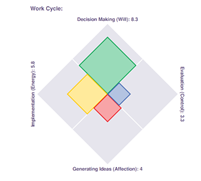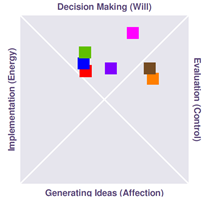COVID19, months of lockdown, hundreds of virtual Teams meetings, embracing new technologies…the list goes on. Whatever rhetoric you choose to apply, we have certainly learnt lots over the past years about the stresses and strains inflicted on businesses and teams, forcing them to adapt and dance to a new rhythm.
But what predictions and conclusions can we make by examining what a team looks like in terms of Facet5?
We have had many requests about how to apply TeamScape in a virtual setting. My response is that there has never been a better time to do it!
Facet5’s TeamScape report can start some great discussions. Let’s take a look at two of the ways in which it presents information about a team’s collective profiles.
1: The Team Overlay
Looking at how a team’s four-factor profiles look when combined can provoke some great questions.
Take the example below:

By examining the clustering of scores, distribution, and gaps, as well as outliers and opposites, we can quickly get a feel for what this team might look like in the situations such as those which have been thrown at us over these past months.
Here are some observations and questions we could ask:
WILL: clustered exclusively towards the higher end of the scale (>5.5); who makes the decisions in this team? How does it deal with differing views and decide its direction?
ENERGY: one cluster mid-high and another quite low (<2.5); how does the team move forward together as a unit? How does it ensure the lower Energy scorers are brought into new ways of working?
AFFECTION: clustered entirely below 5; what does the team do to accommodate each others’ needs? How does it capitalise on the range of possibilities and opportunities?
CONTROL: evenly distributed but without any extremes (<3 or >8); how does the team balance its need for structure and respect for tried and tested ways, whilst working with the need to reconsider how things are done for the future?
EMOTIONALITY: not listed in this diagram; although not included in the team overlay, it is worth considering the team’s Emotionality scores, and how they might affect team dynamics. For instance, those with middle range scores might find that their Emotionality shows up on some occasions, and not others.
2: The Team Snapshot and Work Cycle
The need to transform means the need for ideas and new approaches. How well teams work together to address challenges and then how they take this forward can be examined well by looking at how well the four stages of the Work Cycle are represented across the different profiles.
 Remember (because we get asked this a lot) that the Work Cycle begins with the generation of an idea, solution or approach and works from there in a clockwise direction.
Remember (because we get asked this a lot) that the Work Cycle begins with the generation of an idea, solution or approach and works from there in a clockwise direction.
So, same team as before, let’s look at the following diagram:

Having many of its members clustered in the top quadrant indicates a dominance of high Will and overall lower Affection. This is a group of decisive, assertive and highly pragmatic individuals. The tendency to want to drive things forward singularly creates a risk in this team that the exploration and discussion of opportunities may not happen. The team is going to be strong on decision making but may find it lacks a range of options.
Are alarm bells ringing? They might be! Where are the ideas coming from in this team? A team with higher levels of Affection overall will probably not only spend more time exploring opportunities, but also give each other the space and respect of hearing everyone’s viewpoints.
As a third observation, this team may have to focus hard to get things moving once it knows what it wants to do; with no profiles sitting obviously within the Implementation quadrant this may prove difficult and could be left to one or two members who are able to be more flexible. There may be a tendency to get stuck in reflection and thinking things through rather than getting on.
IMPORTANT: we are all able to demonstrate a range of behaviours. By raising risks as well as strengths, it can focus a team’s priorities so as not to overlook important aspects of individuals’ profiles. To explore this, it is a good idea to look at the ‘Individual’s Contribution to the Work Cycle’ page of the TeamScape report.
So, overall we can see that examining the combinations of factor scores within a team uncovers clues as to how a team might be ready to perform in times of change.
How ready are you and your teams to transform?
How would you like to start a conversation? Click on the icons below, or use our interactive video tool.